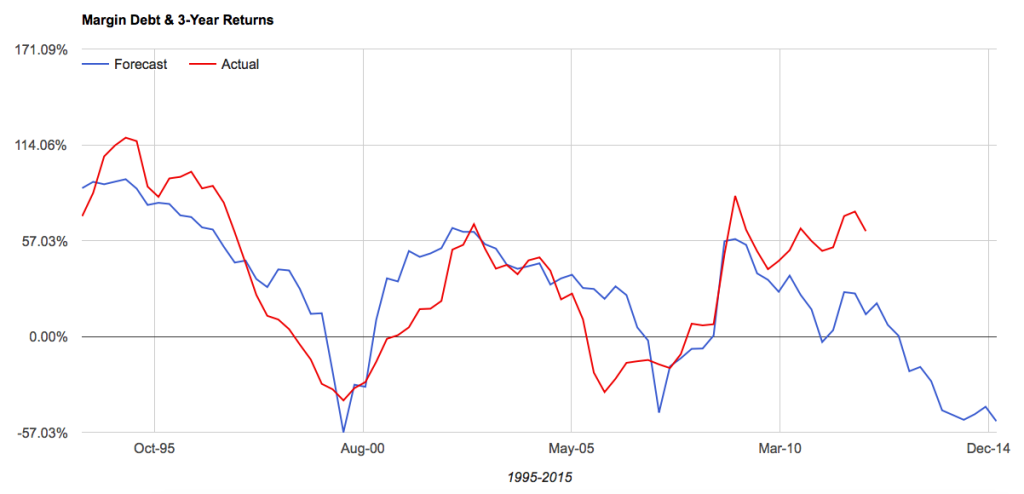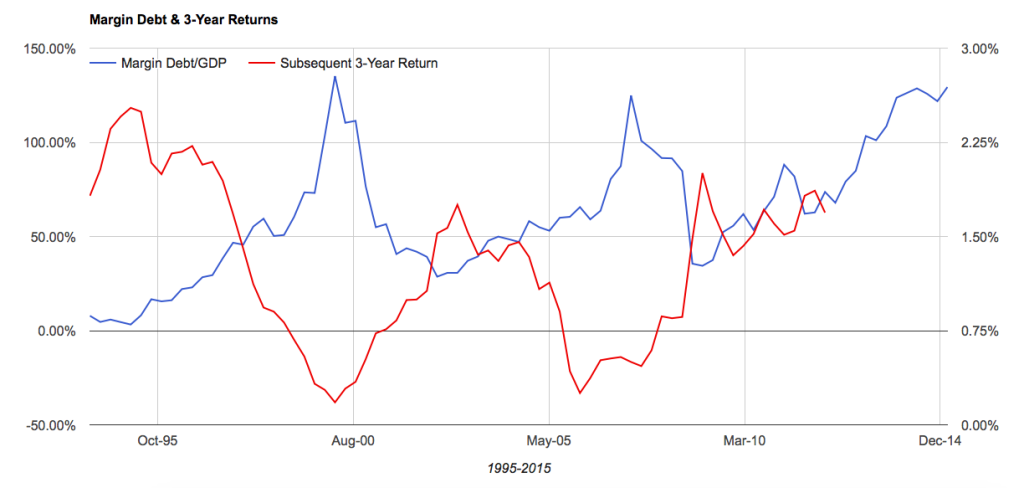It’s recently become popular to dismiss the record level of margin debt in the market as meaningless. Notable bloggers like Josh Brown, Barry Ritholtz and Chris Kimble have all written some sort of “it just doesn’t matter” commentary recently. Barry went so far as to call it, “statistically bogus.” To me, this sounds like just another version of, “it’s different this time.”
Saying margin debt doesn't matter to the stock market is the same as saying supply and demand are irrelevant to asset prices.
— Jesse Felder (@jessefelder) April 30, 2015
Here are the real statistics: Over the past 20 years, the level of margin debt relative to the economy has had nearly an 80% negative correlation to future 3-year returns in the stock market. What this means is, the higher the level of margin debt relative to GDP, the lower the returns for the stock market over the coming 3 years and vice versa. “Statistically bogus?” I think not.
So what is the current level of margin debt suggesting for the next 3 years in stocks? Considering that margin debt-to-GDP is near an all-time record high, it forecasts returns over the coming 3 years could very well be as bad as any bear market we have witnessed over the past 20 years. Specifically, it forecasts a negative 3-year return of 50%. Maybe this is one reason Julian Robertson recently said it’s not “ridiculous” to expect another 2008-size decline in the stock market.
 Now I’m not saying that this one indicator should be relied upon on its own in making investment decisions. 20 years of data is not much and it’s only one of many valuable indicators. But to call it meaningless is either willful ignorance (aka, cognitive dissonance) or disingenuousness.
Now I’m not saying that this one indicator should be relied upon on its own in making investment decisions. 20 years of data is not much and it’s only one of many valuable indicators. But to call it meaningless is either willful ignorance (aka, cognitive dissonance) or disingenuousness.
Because it is statistically significant, it is very valuable in, as Howard Marks says, “having a sense for where we stand.” From The Most Important Thing:
As difficult as it is to know the future, it’s really not that hard to understand the present. What we need to do is “take the market’s temperature.” If we are alert and perceptive, we can gauge the behavior of those around us and from that judge what we should do… Simply put, we must strive to understand the implications of what’s going on around us. When others are recklessly confident and buying aggressively, we should be highly cautious.
In my view, margin debt is a very good way to “take the market’s temperature.” The extreme level of margin debt-to-GDP clearly shows investors have become “recklessly confident.” Prudent investors should react by becoming more cautious. And, from a contrarian standpoint, the fact that popular bloggers are dismissing this idea despite its mathematical validity adds an exclamation point to that idea.
